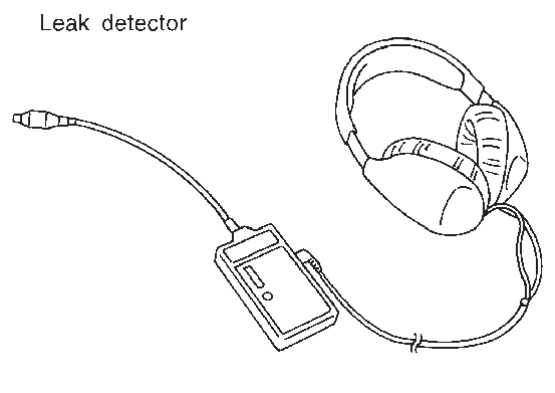EVAP CANISTER : Periodic Maintenance
| caution |
|
| note |
|
WITH M.U.T.-III SE
1. Install EVAP service port adapter [commercial service tool: (J-41413-OBD)] and pressure pump to EVAP service port.
| note | If vacuum delay valve does not have EVAP service port, remove vacuum delay valve and install EVAP service port [commercial service tool: (Part No. 149393S500)] instead. |
2. Turn ignition switch ON.
3. Select the “EVAP SYSTEM CLOSE” of “WORK SUPPORT” mode with M.U.T.-III SE.
4. Touch “OK”. A bar graph (Pressure indicating display) will appear on the screen.
5. Apply positive pressure to the EVAP system until the pressure indicator reaches the middle of the bar graph.
6. Remove EVAP service port adapter [commercial service tool: (J-41413-OBD)] and hose with pressure pump.
7. Locate the leak using a leak detector [commercial service tool: (J-41416)]. Refer to System Description .
.
 .
. WITHOUT M.U.T.-III SE
1. Install EVAP service port adapter [commercial service tool: (J-41413-OBD)] and pressure pump to EVAP service port.
| note | If vacuum delay valve does not have EVAP service port, remove vacuum delay valve and install EVAP service port [commercial service tool: (Part No. 149393S500)] instead. |
2. Apply battery voltage between the terminals of EVAP canister vent control valve to make a closed EVAP system.
3. To locate the leak, deliver positive pressure to the EVAP system until pressure gauge points reach 1.38 to 2.76 kPa (0.014 to 0.028 kg/cm2, 0.2 to 0.4 psi).
4. Remove EVAP service port adapter [commercial service tool: (J-41413-OBD)] and hose with pressure pump.
5. Locate the leak using a leak detector [commercial service tool: (J-41416)]. Refer to System Description .
.
 .
.![[Previous]](../../../buttons/fprev.png)
![[Next]](../../../buttons/fnext.png)

